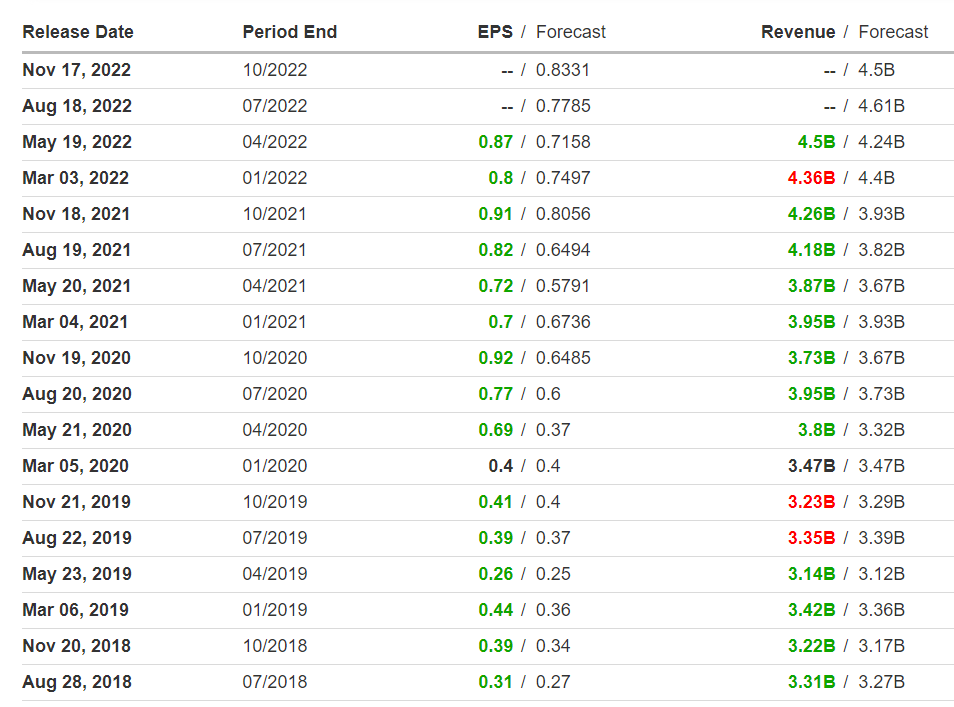- BJ’s Wholesale Club has been a top performer in the retail space this year.
- The shares are up 5.7% year-to-date and are trading near their record high.
- BJ is a strong buy ahead of its Q2 results next week.
The major U.S. retailers—which are perhaps the most sensitive to economic conditions and consumer spending—will be the final group of companies reporting earnings this season when they deliver their Q2 results next week.
The sector has struggled this year as it deals with lingering supply chain issues, rising raw material costs, as well as potential changes in consumer behavior as high inflation, is causing disposable income to shrink.
The retail sector’s main ETF—the SPDR® S&P Retail ETF (NYSE:XRT)—has lost over 22% year-to-date (ytd), underperforming both the Dow Jones Industrial Average and the S&P 500, which are down about 8.3% and 12% respectively over the same timeframe.

Despite the recent downtrend, there are still a few names in the battered space which are performing well and whose earnings are anticipated to show solid sales growth and only a modest impact from inflation.
I believe BJ's Wholesale Club (NYSE:BJ), which operates more than 200 warehouse clubs and gas stations in 17 states across the Eastern U.S., is an ideal value pick for investors looking to hedge against further market volatility.
The membership-only warehouse club chain mostly sells groceries, household products, and gasoline at discount prices, underlining the retailer’s recession-proof status.
Indeed, shares of the Westborough, Massachusetts-based company have held up better than some of their larger competitors, easily outperforming industry bellwethers Walmart (NYSE:WMT), Target (NYSE:TGT), and Costco (NASDAQ:COST).
The stock has climbed around 35% since hitting a low on May 20, 2022, putting it back within sight of its all-time high from November 2021 of $74.09.

In my view, BJ’s business model remains more relevant than ever as bargain-hunting consumers increasingly shop at discount stores.
Not surprisingly, BJ’s Wholesale Club has topped Wall Street’s profit expectations in every quarter since Q2 2018, highlighting the strength and resilience of its business. It has also delivered year-over-year (yoy) sales growth for 12 straight quarters, which I expect to continue when it reports its latest financial results before the opening bell on Thursday, August 18.

Consensus calls for earnings per share of $0.77 for Q2. Revenue is forecast to rise about 10% yoy to a record $4.61 billion, reflecting growing demand. BJ’s update regarding its total comparable club sales—the key retail metric which measures same-store sales performance—jumped 14.4% in the last quarter.
BJ’s online sales increased 26% in Q1, far exceeding expectations as the retailer’s ongoing push to expand its e-commerce offerings is finally starting to pay off so the comparable figure this quarter will be in focus.
Membership fee income, which rose to $96.6 million in the previous quarter is also due to easily surpassing estimates. Unlike Walmart and Target, BJ’s gross profit and operating margins are bolstered by its increasing number of subscribers and steady membership fees, more similar to Costco.
In addition, market participants will pay close attention to the discount warehouse retailer’s outlook for the months ahead as it finds new ways to win over shoppers as Americans cut back spending on discretionary items and divert more spending into basic needs.
Bottom Line
Despite its robust ytd performance, BJ’s Wholesale Club remains one of the best names to own in this challenging environment, thanks to its strong fundamentals, long-term growth prospects, and inexpensive valuation.
With a price-to-earnings (PE) ratio of 20.2, BJ’s stock is significantly cheaper than competitors including Walmart, Costco, Ollie’s Bargain Outlet, Dollar General (NYSE:DG), and Dollar Tree (NASDAQ:DLTR). Additionally, BJ is trading at a discount to the S&P 500’s PE ratio of 22.6.
Disclaimer: At the time of writing, Jesse owns shares of BJ’s Wholesale Club. The views discussed in this article are solely the opinion of the author and should not be taken as investment advice.
